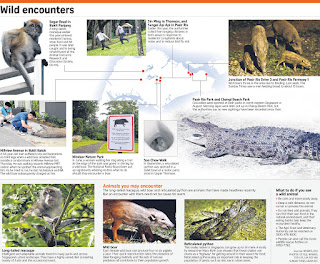Singapore, jungle city: Can humans and wild animals co-exist?
Singapore, jungle city: Can humans and wild animals co-exist?

It's a jungle out there in the Garden City. As Singapore's greening efforts take shape, more reported cases of run-ins between man and beast - some with serious consequences - are emerging.
Monkeys have been terrorising people in their homes. Wild fowl have caused a flap. And then, just last Thursday, a wild boar charged at a man walking past a condominium in Hillview Avenue to the MRT station. The 44-year-old man suffered cuts to his legs.
Wild boars were also in the spotlight last month when five people were taken to hospital after vehicles collided with the animals.
A long-tailed macaque, meanwhile, wreaked havoc for months in the homes of Segar Road residents in Bukit Panjang, entering units and biting people. It took a team comprising wildlife rescue group Animal Concerns Research and Education Society, the Wildlife Reserves Singapore and the Agri-Food and Veterinary Authority (AVA) to catch it in May.
While some marvel at the weird and wonderful wildlife in urban areas here - WhatsApp groups have been created to alert nature enthusiasts about otter sightings, for example - unpleasant animal encounters are upsetting others.
Auditor Anita Srinivasan, 38,who lives in a condo close to where Thursday's boar attack happened, says: "I'm worried for my kids. The lights at our walkway are always dim, so it's hard to see animals."
All this highlights the importance of Singapore's animal management strategies.
AWASH WITH WILDLIFE
Figures from AVA show a growing number of reports made about animals over the years, with feedback relating to monkeys and snakes topping the list.
AVA received 770 reports on monkeys in 2014. Between January and September this year, this grew to 1,170. For snakes, the figure was 610 in 2014, and 1,100 for the first nine months of the year. As for wild boars, AVA received 30 wild boar-related reports in 2014, and 190 between January and September.
What is drawing wildlife into Singapore's urban spaces? No studies have been done to conclusively determine this. But experts point to several reasons.
First, it could be a consequence of Singapore's City in a Garden drive.
The Republic outshone 16 cities in a recent study on urban tree density by researchers from the Massachusetts Institute of Technology and the World Economic Forum. Almost 30 per cent of Singapore's urban areas are covered by greenery. This puts Singapore ahead of Sydney and Vancouver, which tied for second place with 25.9 per cent.
"Planting up the landscape can improve or create a habitat. It may also create suitable linkages or refuge for wildlife between existing habitats. Some mammals that have benefited are the plantain squirrel and long-tailed macaque. It is possible civets use them too," says NUS' Mr Chua.
The oriental pied hornbill - an endangered bird native to Singapore - is practically the poster child for the Republic's greening efforts. The species was extinct here for nearly a century, but recolonised Pulau Ubin in the early 1990s.
Due to an extensive reintroduction programme, the hornbills have gone on to spread more widely on mainland Singapore - even showing up at urban condominiums, such as Country Park Condominium in Bedok.


Comments
Post a Comment